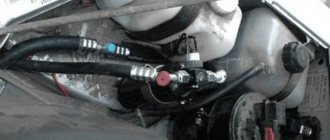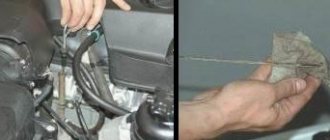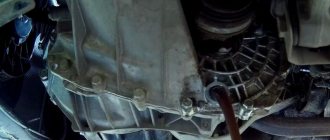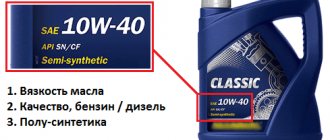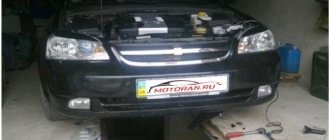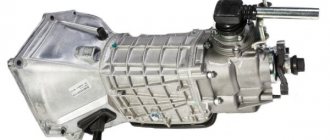The recording is more for myself, but maybe it will be useful to someone else. Since after the purchase I only changed the oil in the engine, and it’s not at all clear what and how much in the transmission, I’m thinking about changing the oils in the gearbox, transfer case and axles. It would be good to know what kind of transmission oil to fill in to reduce the howling of the transfer case.
Fuel tank 58.0 l Engine cooling system 8.0 l Engine lubrication system 3.75 l Gearbox housing 1.6 l Transfer case housing 0.79 l Front axle housing 1.15 l Rear axle housing 1.3 l Hydraulic brake system 0 .5 l Hydraulic clutch release system 0.15 l Windshield washer reservoir 5.0 l Tailgate washer reservoir 2.0 l Front shock absorber 0.15 l Rear shock absorber 0.215 l Power steering 1.7 l Air conditioning: refrigerant 0.650 kg Air conditioning: oil 0.22 l
Places for lubrication, filling, processing
Motor oils SUPER type (classification according to SAE; API) Engine lubrication system Viscosity class according to SAE: 5W-30: from –25 to +20 °С 5W-40: from –25 to +35 °С 10W-30: from -20 up to +30 С 10W-40: from -20 to +35 С 15W-40: from –15 to +45 С 20W-40: from –10 to +45 С Level of performance properties: according to API SG, SH , SJ according to ASEA A2 according to CCMC G3, G4
Transmission oils (SAE classification; API) Gearbox, Transfer case Viscosity grade according to SAE: 75 W-90; 80 W-85; 80 W-90; Performance level: according to API: GL-4 or universal: GL-4/ GL-5 Front axle, Rear axle, Steering gear Viscosity grade according to SAE: 80 W-90; 85 W-90; Performance level: according to API: GL-5 or universal: GL-4/ GL-5 Power steering: Pentosin Hidraulik Fluid CHF11S VW52137
Greases Front wheel drive joints CV joints-4M, SPECTROL CV joints MoS2 TU 0254-001-0014882 Front suspension ball joints, Steering rod joints ShRB-4 TU 38.USSR-201-143 Cardan shaft joints Litin 2 TU 0254-311- Dowcorning Pressure regulator DT-1 TU 38-USSR-201-116
Brake and clutch hydraulic drive system Brake fluids type DOT-4 SAE J 1703, FMSS116
In this article we will talk about how to change the oil in the gearbox, transfer case and axles of a Chevrolet Niva. The use of high-quality lubricants for vehicles plays an important role in the operation of any car. The most common process for proper vehicle operation is the oil change process . It is possible to change the oil yourself, without resorting to the help of auto service employees, while significantly saving money.
Which oil for the Chevrolet Niva gearbox should you choose?
The Chevrolet Niva is an all-wheel drive vehicle. Properly selected oil for the transfer case, as well as all axles of an SUV, guarantees long-term operation of all vehicle transmission mechanisms. Oil helps reduce friction, which means the period of wear of parts increases significantly. The table below shows the characteristics of filling fluids for the Chevrolet Niva, taken from operating instructions
When choosing transmission oil for a Chevrolet Niva SUV, you should follow the recommendations of the vehicle manufacturer. It is better to purchase gear oil in special auto stores. It is best to give preference to proven, well-known brands. It is important to pay attention when buying oil for what period of the year it is intended. There are oils for summer, winter, and all seasonal. Worth remembering! If the vehicle was purchased with mileage, then it is necessary to check the oil level. It would also be a good idea to change all the oils.
Filling volumes Niva 2131
Chevrolet Niva is the most affordable all-wheel drive SUV on the Russian market. Despite the outdated design, the car is still as relevant as ever. This is facilitated not only by the utilitarian classic design, but by the legendary maintainability. The simple design allows you to service the car in a garage using available tools. It will not be difficult to change the oil in the gearbox, but special attention in this article is paid to the volume of oil in the transmission. However, it is equally important to know other parameters, including the frequency of oil changes, how to choose the right one, and which best brands to choose.What kind of oil should I pour into the Chevrolet Niva transmission?
The choice of oil for the transmission of a Chevrolet Niva car is carried out on the principle of inadmissibility of mixing oils whose compositions are different. Regarding the viscosity characteristics of oils, it is better to give preference to the use of the following oils:
- 75w-90;
- 80w-85;
- 80w-90.
Oils intended for distribution in SUVs are designated by the API GL-4 index. To replace, you will need a small amount of oil: approximately 0.8 liters. When you first fill the Niva transfer case with oil, you should remember how much oil is used. This will allow subsequent oil changes to be carried out without difficulty.
Based on the experience of auto repairmen and car enthusiasts, good transmission oil for Chevrolet Niva is produced by the following manufacturers:
- Gazpromneft: G-Box GL-4/GL-5 75W-90, G-Box GL-5 75W-90;
- Lukoil: TM-4 75w-90, TM-5 75w-90;
- Shell: Spirax S4 G 75W-90 (Getriebeoil EP), Spirax S5 ATE 75W-90 (Transaxle Oil), Spirax S6 AXME (Spirax ASX);
- Castrol: Syntrax Universal Plus 75W-90, Syntrans Transaxle 75W-90, Syntrans Multivehicle 75W-90;
- TNK: Trans KP Super 75W-90, Trans Gipo >Chevrolet Niva gearbox oil change
To change the oil in a Chevrolet Niva gearbox, you will need the following tools:
- steel hex key 12;
- wrench 17;
- container for draining used lubricant.
The sequence of actions for changing the oil in the Niva gearbox is as follows:
- Place the car over an inspection hole or drive it onto an overpass for ease of work. Before draining the old transmission oil, it is necessary to warm up the engine . This is necessary in order to drain the oil from the box as much as possible and without residue.
- Lower yourself into the inspection hole and place a container under the drain hole, taking into account the bend of the exiting stream. It is convenient to use a funnel.
- Clean the locations of the filler and drain plugs on the gearbox, as shown in the photo above.
- First, it is better to unscrew the filler plug, and then the drain plug using a hexagon.
- Now you need to wait until all the used oil has drained to the last drop.
- The drain plug has a special magnet to which all metal shavings are attracted. If there are steel particles on the plug, they must be removed. And another important point from a diagnostic point of view - the more of these particles are present on the cover, the less the gearbox will last.
- When the old used oil is glass, you need to screw in the drain plug and start flushing the crankcase. To do this, you need to fill in about 1 liter of special flushing fluid and let the car run for 2-3 minutes. In this case, you need to turn on neutral in the transfer case and change gears with the clutch.
- Next, the flushing liquid is drained in the same way and new oil is poured in its place in the required volume.
- After filling the oil, you need to check its level on a level surface and start the engine. to let the engine run in first gear for 2-5 minutes After this, the oil level is checked and if it has dropped, then you need to add a little more.
What to choose for bridges
In most cases, the oil chosen for axles is the same as for the transfer case. Their full compliance guarantees you high functionality of all components of the transmission during active daily use of the car. Most car enthusiasts agree that you should only buy proven lubricants. These include products from the following brands:
- Castrol;
- Lukoil;
- Liqui Moly;
- Mobil;
- Shell;
- Elf;
- ZIC.
This is a list of the most popular and widely used brands. Their products are used by a huge number of car enthusiasts with different experience levels. When purchasing, be sure to check the compatibility of the viscosity and chemical composition with the oil already used in the gearbox.
Read news about the new Niva
- How to fix an oil leak from a gearbox
- UAZ or Niva - which is better, car characteristics and features ::
- FROST car air conditioners // Online store // Prices // Air conditioners for cars Lada VAZ, VolksWagen Polo, Daewoo Matiz
- Niva Chevrolet transfer case: device, connection diagram and how to use?
- Quantity of oils and fuel liquids VAZ 4×4 2121 Niva
- Transmission Niva Chevrolet: diagram and principle of operation
- How much oil is in the Niva 21214 engine
- What kind of oil to pour into the VAZ 21214 Niva engine injector
Changing the oil in the transfer case of a Chevrolet Niva
As for this car model, the oil needs to be changed every 50-80 thousand kilometers . As soon as the car has traveled more than 120 thousand kilometers, the oil should be changed every 45 thousand kilometers. For information! The vehicle operating instructions contain information on the frequency of oil changes, which every car owner must follow. But it would be better if the oil change procedure is carried out a little more often. This is due to the fact that car oil accumulates dust and dirt, which over time leads to contamination of vehicle traffic mechanisms. This is why many car owners advise changing oils more often than indicated in the instructions. To ensure that the oil can be drained without problems, you should start replacing it after the trip. On the way, the oil has time to heat up, thereby taking on a more liquid consistency. Changing the oil in the transfer case is not as difficult as it seems at first glance. To replace it, you need to drive the vehicle into an inspection hole, or raise the car on a lift. You will need a container designed to drain the oil, as well as a rag to remove all smudges. Do not forget about the hex wrench (size 12), and you also need to have a refill syringe .
Draining and filling oil into the Chevrolet Niva transfer case
1. First of all, unscrew the drain plug. Then the oil is poured into the prepared container. 2. The old oil is checked for metal shavings. It is also worth paying attention to the built-in magnet - inspect it. 3. Impurities and dirt on the stopper should be cleaned. Afterwards the plug should be screwed back on. 4. The filler hole has a screw-on plug; it must be unscrewed. 5. Transmission oil is poured through a filling syringe. The ventilation valve is inspected and cleaned . 7. It is necessary to remember or note in a notepad the mileage that was on the car at the time of the oil change.
Recommended intervals
The vehicle service manual clearly defines the service interval for servicing transmission units. Here it is 45,000 kilometers. But there is an important nuance in the segment - the manufacturer implies moderate operation of the machine in low-load mode.
In reality, everything is less trivial. To select the correct time period, you should take into account the aggressiveness of the vehicle, the quality of the lubricant and the condition of the transmission. Experienced car enthusiasts prefer not to delay the maintenance of units and change the lubricant already at 25,000-30,000 km. This helps prevent excessive fluid wear and reduces the risk of block damage. But some people don’t care and ride 200 thousand and everything is fine.
Recommendations for intervals and volumes are for normal use. It is impossible to determine exactly how long you can drive on a particular oil, because each lubricant has its own expiration date. It’s normal to make a replacement at least once every 50 thousand, but if it’s all the same for the car, then once every 200,000 km will do.
Specialization : Graduated from the State Automobile University, worked for 20 years at GAZ-56, now I drive a Zhiguli.
Source
Changing the oil in the axles of a Chevrolet Niva SUV
For this procedure, it is recommended to follow vehicle maintenance, as well as the rules for repairing an SUV. Oil changes in vehicle axles should occur every 40 thousand kilometers (applies to cases of Niva operation under normal conditions ). If the car is operated in more difficult conditions, then the oil should be changed much earlier.
Preparation for changing the oil in Chevrolet Niva axles
Changing the oil in a vehicle's axles is identical to the procedure for changing the fluid in the transfer case. You should drive the SUV onto a viewing hole or onto a lift. The volume of oil required is the same as for the transmission. Before changing the oil, you should warm up the Niva. Next, you will need a 12-mm hex key, a 17-mm socket with a knob, a container for draining the used oil, and a rag. You should also make sure you have a refill syringe.
Stages of oil change in Chevrolet Niva axles
1. Unscrew the drain plug. 2. The bolt magnet is inspected to determine whether there are chips on it. If there are no chips, the bolt is screwed back in. 3. The used oil is drained into a prepared container. 4. The drain plug is screwed on and tightened - this procedure applies to the rear axle. 5. The filler plug is unscrewed. 6. Using a filling syringe , add oil in the required volume. 7. The filler plug is screwed in and tightened - again we are talking about the rear axle.
Changing the oil in the front axle of a Chevrolet Niva is shown in more detail in the video.
For details on changing the oil in the rear axle of a Chevrolet Niva, watch the video.
even an inexperienced driver can change the oil in Niva on his own if he follows all the necessary recommendations and the above. If you have any questions about changing the oil in the Niva transmission, ask them in the comments - our specialists will answer them.
Using high-quality transmission fluids for any vehicle is the main factor in preventing malfunctions and extending its service life. Over time, the lubricant loses its protective properties. Therefore, correct and timely oil changes in all transmission mechanisms will be the key to reliable operation of the vehicle. The oil in axles in a Chevrolet Niva can be changed either at a service station or with your own hands if you have some experience.
How to change the oil?
How to independently replace technological fluids in a Niva Chevrolet? To do this, you need to purchase high-quality oil, which is recommended by the manufacturer. All required volumes are indicated in the instructions for the car. For beginners, the replacement process will seem complicated, but in fact it is not.
The choice of oil for an all-wheel drive vehicle is a very important point; the service life, wear of parts and the operation of all transfer gear mechanisms depend on it. You need to buy liquids that are recommended by the manufacturer or proven, well-known brands. There are different types of oil for different seasons, they differ in viscosity and are adapted to work at a certain temperature.
If the car was purchased used, it is better to immediately check the level of all fluids and replace them.
When to change
For prevention, according to the manufacturer's instructions, you should periodically change the lubricant of both axles of the car every 45 thousand kilometers or after three years of operation. If the machine is often used off-road or at low temperatures, then this interval should be reduced. Also, the appearance of external disturbances in the operation of the transmission, caused by a whistle, increased hum, knocking when starting from a stop and at speed, signals the need to check the level and quality of the transmission fluid.
After purchasing a used car, after major repairs, you also need to change the lubricant. The longer the mileage becomes (especially after 100 thousand kilometers), the more often such maintenance should be carried out.
Replacing brake fluid
Based on the technical characteristics of the car, brake fluid is added to the hydraulic brakes once every three years or after 50 thousand km. To do this, you need to pump out the old fluid from the tank, fill in new one and pump the hydraulic drive until the remnants of the old fluid are removed from the system. Bleeding is carried out with the engine turned off in the following sequence:
- Rear wheel brakes on the right side.
- Left front wheel.
- Rear wheel brake on the left side.
- Right front wheel brakes.
After bleeding the brake system, the missing volume of fluid is added to the reservoir.
Which oil should you choose?
Experienced drivers know what kind of oil to pour into Niva axles and how much of it is required. The oil poured into the rear axle gearbox is the same as into the front axle. For axles, according to official instructions, lubricant type 80W90, 85W90 with API specification GL-5/GL-4 is required. It is advisable to change the oil to a product of the same type and manufacturer. Choose from reliable manufacturers of well-known brands: Lukoil, Shell, Castrol, TNK, etc. You can also use the popular universal lubricant 75W90.
To carry out the replacement procedure, the following volume of fluid is required:
- front axle housing – 1.15 liters;
- rear axle housing – 1.3 liters.
What to fill: factory recommendations
Chevrolet Nivas leave the assembly line with a mineral transmission, which has a viscosity of SAE 75W-90, 80W-85, 80W-90 and complies with the API GL4 or GL4/GL5 standard.
However, according to the observations of car owners, replacing mineral water with synthetics or semi-synthetics has a positive effect on the operation of the transmission:
- The gearbox is quieter.
- There is less vibration when moving.
- Makes gear shifting easier in winter.
Important! The popular oil of the API GL-5 standard cannot be filled into the gearbox and transfer case of the Chevrolet Niva. Its use will lead to rapid breakdown of the units.
Preparing for replacement
The process of changing the lubricant yourself will take a little time - an hour or an hour and a half. But you need to prepare first. A set of tools, devices, and consumables is selected. You will need a 12mm hex key and a 17mm socket head, a container for waste fluid, dry rags, and sealant. For filling, you can use a special filling syringe (pump) or another device (funnel with hose). Copper sealing rings are placed on the crankcase plugs. Therefore, you need to prepare them in advance. Work is carried out with protective gloves.
Cooling systems.
The cooling system here is liquid, closed type. This includes a radiator, pump, sensor. thermostat, fan, expansion tank, hoses, etc. The capacity is 8 liters.
The expansion tank is located next to the brake booster. Installed markers allow you to quickly determine the fluid level. It is important that everything is completely sealed, so the inlet and outlet valve monitor and regulate the pressure.
The tubular-plate radiator is made of aluminum and has plastic tanks. Coolant Antifreeze A-40 M for this system is poured through the expansion tank.
Carrying out an oil change
Let's look in detail at how to change the oil in axles. The main steps of the procedure are identical to changing the lubricant in the transfer case. First, the fluid in the gearboxes warms up. To do this you need to drive about five kilometers. Then the car is driven onto a viewing hole, overpass or lift. The waste is poured into prepared containers. Its condition is assessed for the presence of dirt and metal particles. New lubricant is added. Possible leaks are checked. You also need to clean the breathers of both bridges. The filler holes are inspection holes for checking the lubricant level. The liquid should be level with these holes.
Changing the oil in the front axle gearbox
Changing the oil in the front axle of a Chevrolet Niva with your own hands is done in the following order:
- Unscrew the drain plug with a 12mm wrench and completely drain the waste into the prepared container. Remember that the liquid is hot.
- Clean the plug and the edges of the hole, replace the gasket, and lubricate the whole thing with sealant.
- Replace the drain plug.
- Unscrew the filler plug with a 17 key. The filler hole is located on the left side in the direction of travel.
- Fill in the lubricant with a special syringe or device.
- Screw in the filler plug.
- Check for leaks. This completes the transmission fluid change.
Other fuel tanks for Chevrolet Niva
Cooling mechanism
The Chevrolet Niva has a closed-type liquid cooling mechanism.
The cooling system includes:
- radiator,
- hydraulic pump,
- indicator,
- thermostat,
- electric fan,
- expansion tank,
- pipelines, etc.
The volume of the cooling system is 8 liters.
The expansion tank is located in close proximity to the brake booster. The marked indicators make it possible to quickly respond to a lack or excess of fluid. The main importance is attached to the tightness of the cooling system. Therefore, inlet and outlet valves regulate this value.
Aluminum radiator tanks are constructed of special plastic. The coolant is supplied through the expansion tank. The parameters for this type of liquid are Antifreeze A-40 M. It is recommended to use antifreeze containing additional components to avoid rust.
Lubrication algorithm
The car has a combined lubrication system. Lubrication is carried out under pressure and is distributed to the following mechanisms:
- main bearing,
- crankshaft connecting rod,
- camshaft bearing,
- oil pump shaft,
- helical gears of the oil pump.
Selected elements are lubricated by spraying.
The oil pump, consisting of one section and having gears in its design, is driven by two gears. Oil purification is carried out using an oil filter element. Oil system pressure is monitored using a light bulb. Signaling a decrease in oil pressure in the system. The lubrication system also includes hydraulic valve stems and a torque chain tensioner.

